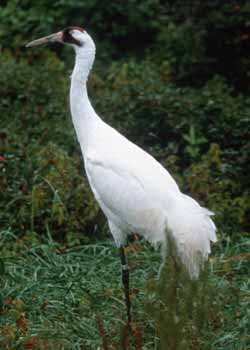The Whooping Crane
(Endangered, 1970)

Description: The Whooping Crane is snowy white it stands about 1.5 metres tall. In flight its black wingtips are observable. The wingspan measures two metres. In the breeding period the whooping cranes are typically found as singles or pairs. Throughout migration they can also be found as singles or in small groups up to about six or seven birds. Usually a group of three birds consists a young bird followed by two adults.
Relatives: The Whooping Crane and the Sandhill Crane are the only wild cranes in North America. Altogether there are 15 species of cranes in the world.
Lifespan: Could live as old as 24 years in the wild
Food: Snails, larval insects, leeches, frogs, minnows, small rodents, and berries. They may hunt dead ducks, marsh birds or muskrats.
Migration: The first whooping cranes to depart the breeding grounds begin their 2,600 mile southern migration in mid-September. The cranes journeys in small flocks of less than ten birds and take between two and six weeks to make the journey. They fly south during the daytime and stop for the night to rest and feed.
Population: Some current record years were 1995, with an increase of 25 cranes; and 1997, with an increase of 22 cranes. The year 1999 was a struggle for the whooping cranes-and disappointing for crane biologists. The flock managed to increase their numbers by only single crane.
Threats: Naturalists believe destruction of breeding habitat was the main reason for its decline. Bigger industrial expansion in the north and elsewhere gives hard times for the Whooping Crane. Power lines, microwave towers, and other structures common in southern North America are dangerous to flying birds; several Whooping Cranes have flown into overhead wires and died.
Location: Whooping cranes nest in undisturbed wetlands with an abundance of bulrush, and winter in salt flats and marshes with upland areas covered by oak and long-stemmed grasses.
Protection: Whooping Cranes are protected in Canada and the United States under the Migratory Birds Convention Act of 1917.the breeding and wintering grounds are in protected wildlife refuges or national parks.
Recovery Efforts: The American and Canadian governments signed a memorandum of accepting on the Conservation of the Whooping Crane in 1985. This agreement led to the progress of a National Recovery Plan for the Whooping Crane. Under the plan, Canada agreed to increase the number of pairs breeding in Wood Buffalo National Park to 40 and to increase the migratory population to 140 birds.
